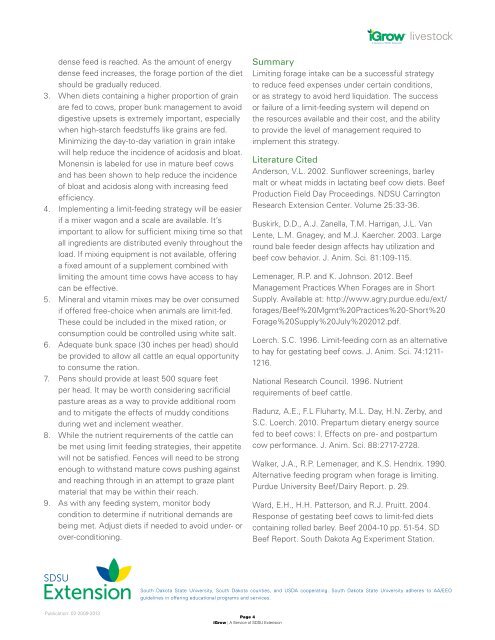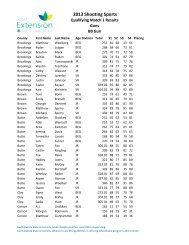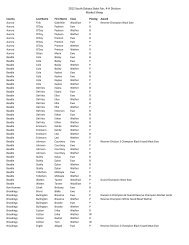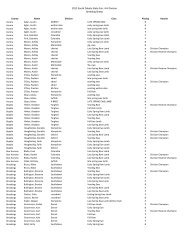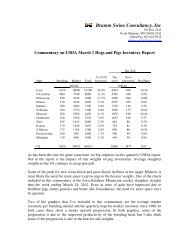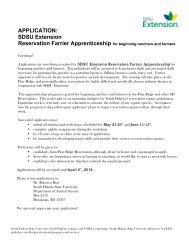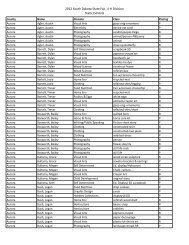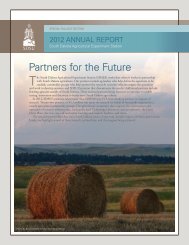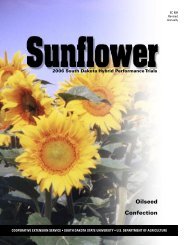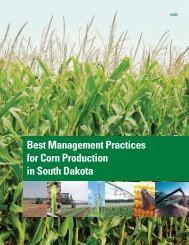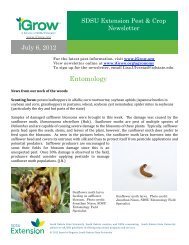Limit Feeding Strategies for Beef Cows (940 KB) Download - iGrow
Limit Feeding Strategies for Beef Cows (940 KB) Download - iGrow
Limit Feeding Strategies for Beef Cows (940 KB) Download - iGrow
You also want an ePaper? Increase the reach of your titles
YUMPU automatically turns print PDFs into web optimized ePapers that Google loves.
livestock<br />
dense feed is reached. As the amount of energy<br />
dense feed increases, the <strong>for</strong>age portion of the diet<br />
should be gradually reduced.<br />
3. When diets containing a higher proportion of grain<br />
are fed to cows, proper bunk management to avoid<br />
digestive upsets is extremely important, especially<br />
when high-starch feedstuffs like grains are fed.<br />
Minimizing the day-to-day variation in grain intake<br />
will help reduce the incidence of acidosis and bloat.<br />
Monensin is labeled <strong>for</strong> use in mature beef cows<br />
and has been shown to help reduce the incidence<br />
of bloat and acidosis along with increasing feed<br />
efficiency.<br />
4. Implementing a limit-feeding strategy will be easier<br />
if a mixer wagon and a scale are available. It’s<br />
important to allow <strong>for</strong> sufficient mixing time so that<br />
all ingredients are distributed evenly throughout the<br />
load. If mixing equipment is not available, offering<br />
a fixed amount of a supplement combined with<br />
limiting the amount time cows have access to hay<br />
can be effective.<br />
5. Mineral and vitamin mixes may be over consumed<br />
if offered free-choice when animals are limit-fed.<br />
These could be included in the mixed ration, or<br />
consumption could be controlled using white salt.<br />
6. Adequate bunk space (30 inches per head) should<br />
be provided to allow all cattle an equal opportunity<br />
to consume the ration.<br />
7. Pens should provide at least 500 square feet<br />
per head. It may be worth considering sacrificial<br />
pasture areas as a way to provide additional room<br />
and to mitigate the effects of muddy conditions<br />
during wet and inclement weather.<br />
8. While the nutrient requirements of the cattle can<br />
be met using limit feeding strategies, their appetite<br />
will not be satisfied. Fences will need to be strong<br />
enough to withstand mature cows pushing against<br />
and reaching through in an attempt to graze plant<br />
material that may be within their reach.<br />
9. As with any feeding system, monitor body<br />
condition to determine if nutritional demands are<br />
being met. Adjust diets if needed to avoid under- or<br />
over-conditioning.<br />
Summary<br />
<strong>Limit</strong>ing <strong>for</strong>age intake can be a successful strategy<br />
to reduce feed expenses under certain conditions,<br />
or as strategy to avoid herd liquidation. The success<br />
or failure of a limit-feeding system will depend on<br />
the resources available and their cost, and the ability<br />
to provide the level of management required to<br />
implement this strategy.<br />
Literature Cited<br />
Anderson, V.L. 2002. Sunflower screenings, barley<br />
malt or wheat midds in lactating beef cow diets. <strong>Beef</strong><br />
Production Field Day Proceedings. NDSU Carrington<br />
Research Extension Center. Volume 25:33-36.<br />
Buskirk, D.D., A.J. Zanella, T.M. Harrigan, J.L. Van<br />
Lente, L.M. Gnagey, and M.J. Kaercher. 2003. Large<br />
round bale feeder design affects hay utilization and<br />
beef cow behavior. J. Anim. Sci. 81:109-115.<br />
Lemenager, R.P. and K. Johnson. 2012. <strong>Beef</strong><br />
Management Practices When Forages are in Short<br />
Supply. Available at: http://www.agry.purdue.edu/ext/<br />
<strong>for</strong>ages/<strong>Beef</strong>%20Mgmt%20Practices%20-Short%20<br />
Forage%20Supply%20July%202012.pdf.<br />
Loerch. S.C. 1996. <strong>Limit</strong>-feeding corn as an alternative<br />
to hay <strong>for</strong> gestating beef cows. J. Anim. Sci. 74:1211-<br />
1216.<br />
National Research Council. 1996. Nutrient<br />
requirements of beef cattle.<br />
Radunz, A.E., F.L Fluharty, M.L. Day, H.N. Zerby, and<br />
S.C. Loerch. 2010. Prepartum dietary energy source<br />
fed to beef cows: I. Effects on pre- and postpartum<br />
cow per<strong>for</strong>mance. J. Anim. Sci. 88:2717-2728.<br />
Walker, J.A., R.P. Lemenager, and K.S. Hendrix. 1990.<br />
Alternative feeding program when <strong>for</strong>age is limiting.<br />
Purdue University <strong>Beef</strong>/Dairy Report. p. 29.<br />
Ward, E.H., H.H. Patterson, and R.J. Pruitt. 2004.<br />
Response of gestating beef cows to limit-fed diets<br />
containing rolled barley. <strong>Beef</strong> 2004-10 pp. 51-54. SD<br />
<strong>Beef</strong> Report. South Dakota Ag Experiment Station.<br />
South Dakota State University, South Dakota counties, and USDA cooperating. South Dakota State University adheres to AA/EEO<br />
guidelines in offering educational programs and services.<br />
Publication: 02-2009-2013<br />
Page 4<br />
<strong>iGrow</strong> | A Service of SDSU Extension


